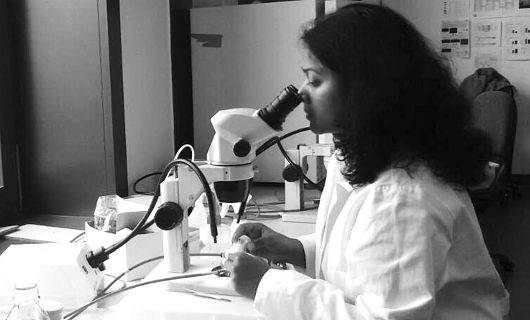Spotlight on Leena Thorat
Spotlight on Leena Thorat

Alex Evans caught up with early career researcher and proud SEB member Dr Leena Thorat to discuss her work on the stress tolerance of insects, as well as how she tolerates the stressors of her own active research career.
I identify myself as a ‘stress biologist’,” says Leena, who is currently working as a Department of Biotechnology ‘biotechnology career advancement and reorientation programme for women scientists’ (DBT-BioCARe) scientist at the Department of Zoology, Savitribai Phule Pune University (SPPU), India. Leena’s research journey started after the completion of her MSc in Zoology from SPPU in 2008 and developed quickly as she qualified with a CSIR-NET-JRF certificate (National Eligibility Test for Teaching and Research in India) and soon enrolled in a PhD programme with Professor Bimalendu Nath at the Department of Zoology, SPPU. “During the tenure of my PhD, I was awarded the German Academic Exchange Service (DAAD) Fellowship to carry out part of my doctoral research in the laboratory of Professor Alexander Brehm at the Philipps-Universität Marburg, Germany,” adds Leena. “After receiving my PhD in 2015, I took up my first post-doctoral fellowship (University Grants Commission-DS Kothari Post-Doctoral Fellowship (UGC-DSK) at the Department of Biotechnology, SPPU.” Thanks to a European Molecular Biology Organisation (EMBO) Fellowship, Leena next took up a post as a research fellow at Freie Universität Berlin, Germany, with Professors Hans-Joachim Pflüger and Stephan Sigrist, before finally moving on to her current position studying the biochemical and molecular nature of aquatic silk proteins produced by chironomid midges.
“I am primarily interested in the physiological biochemistry and cellular, molecular, and genetic mechanisms underlying desiccation stress tolerance using two ecologically distinct and evolutionarily distant insect models, Drosophila (fruit fly) and Chironomus (aquatic midge).” Although Leena is now very familiar with these research concepts, her first experience in the desiccation of invertebrates was unintentional, at the start of her PhD programme. “The selection of my final PhD topic is actually an interesting story,” she explains. “I had just come back to the lab from Easter leave and found that my Chironomus culture tubs had gone totally dry. To my surprise, although these nests were dry, when I poured water on them to clean prior to discarding them, I saw that the dry larvae inside the nests started to revive!” Since this revelation, Leena’s research has focused on the phenomenon of desiccation tolerance and anhydrobiosis (life without water) in two different insect groups. “Unlike Drosophila, Chironomus is a lesser known biological model system in the Indian context,” Leena explains. “Through my doctoral research, I established Chironomus as a potential model for desiccation stress response studies at the backdrop of prevailing issues of global warming.” The novelty of Leena’s work lies in the identification of differential regulation of stress-alleviating metabolites specific to Drosophila and Chironomus and their associated mechanisms. For instance, in Chironomus, Leena found the unique desiccation-triggered involvement of the trehalose–chitin metabolic interface through recruitment of glucosamine, which was completely absent from Drosophila.

Leena Thorat Photo:Thomas Thorat
“Drosophila evolved around 150 million years after Chironomus, so I engaged myself to unravel the unique adaptations evolved in these two systems to combat environmental desiccation bouts,” Leena says.
Building on her current work with desiccation, Leena would like to explore the effects of specific environmental stressors on invertebrate life even further. “At present, desiccation is emerging as one of the most environmentally relevant climatic stressors and insects are enormously prone to episodic desiccation events in nature,” she explains. “Therefore, I would like to explore the desiccation-responsive neuronal circuitry using Chironomus and Drosophila, especially how the neuronal control of motor behaviour in desiccated larvae ensures successful revival upon rehydration and recovery.” Leena adds that her ultimate aim is to use this fundamental information from Chironomus and Drosophila as representative models of invertebrate brains for translational research in the mitigation of future droughts.
Leena’s research interests extend beyond the desiccation tolerance of these two invertebrate taxa. “I am also interested in investigating the biochemical, biophysical, and molecular nature of aquatic silk protein from the chironomid midge,” she explains. “My routine lab observations of the inherent nest-building behaviour of Chironomus larvae got me fascinated in how they used proteins discharged from their salivary glands to bind the substratum particles together.” Whilst the silk-producing qualities of silkworms and spiders are very well studied, it appears that little is known about the silk produced by chironomids. “In particular, I am curious to understand the biochemistry behind the silk-spinning ability of midges under water in contrast to the terrestrial silks spun by silkworms and spiders,” explains Leena. “Although I only started this work a year ago, preliminary results have provided us with compelling evidence that the aquatic midge silk has a few strikingly superior qualities compared to its terrestrial counterparts!”
Leena says that some of the greatest highlights of her career so far include the professional awards and honours that have been not only professionally rewarding but also personally enriching. “For example, my DAAD and EMBO fellowships have given me great opportunities to gain hands-on training and expertise in key research areas, as well helping to project my research to a global audience and expose me to people from different parts of the world,” she explains. Leena also enjoys her roles as a science educator and writer. “My contributions to science pedagogy through delivering lectures to school and undergraduate students and as an invited author in science periodicals has always doubled my joy as a science professional,” she says.
“Very recently, I was also appointed as an Invited Review Editor in a reputable physiology journal, which is another welcome feather in my cap!” Leena acknowledges that the life of a research scientist isn’t always a stable or secure one, with grant and manuscript rejections as an unavoidable fact of life, but she believes that striving for positivity can be important for career development. “I always remind myself of this apt quote by Oprah Winfrey: ‘Turn your wounds into wisdom!’” Leena explains. “Be bold, keep trying, and learn from your previous experiences.” For early career researchers, she offers the following advice: “Even if your progress seems stagnant, try not to compromise on your enthusiasm and zeal. Make sure to take regular breaks from your work and sit down with yourself once in a while to review your failures, re-establish your work strategy, and to set yourself goals.”
“I feel very honoured to be a member of the SEB,” says Leena. “This society caters to the professional needs of a wide range of biologists from early career scientists to established professors, and their travel grants make it possible for the younger scientific community to participate and communicate their work.” Finally, when Leena isn’t working hard in the field or laboratory, she enjoys painting and experimenting with new recipes in the kitchen. She finds that the best way to wind down from the mental workout of her research is with a relaxing physical workout. “On a daily basis, after my lab work, I spend one hour in the evening doing some form of physical activity such as Zumba, dance aerobics, or even just a brisk walk,” says Leena. “This one hour gives me an outlet to calm myself down at the end of a gruelling day and gears me up ready for the next one!”
